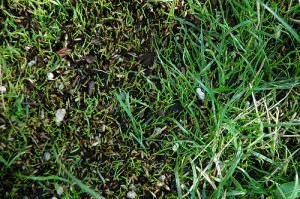Over time, bare spots may start appearing in your lawn. These can be due to insects, diseases, summer stress or thick thatch. Once you have successfully treated the underlying problem, you can work on repairing your grass. If the damage is not extensive, an inexpensive way to do this is to sow new seeds over the existing lawn.
The perfect time to do this is coming up, as your new grass plants will do best if planted at the end of August or beginning of September. The worst of summer (heat, drought, weeds) is over and fall rainstorms will help keep your seedlings watered. You do not want to perform this task later than this, though, as you run the risk of frosts harming the new plants.
Mowing
The first step is mowing your lawn. The University of Nebraska Extension Service mentions that it should be about 1.5″ high at this time. This will allow the seeds to be able to hit the ground. It also means that more sunlight and water will reach your seedlings.
Thatch
Next, you need to determine if you have a problem with thatch. If it is not too thick, you can simply run a rake over the lawn to help loosen up the soil a bit. Otherwise, you will need to remove the thatch layer so your new grass will not have problems growing. UNES suggests either using a power rake, a sod cutter or a core aerator.
Seeding
Once the thatch is gone, you can start seeding. Call Cornell University’s Extension Service to see what varieties they are currently recommending for our area. As Healthy Lawns, Clean Water advises, “Overseeding rates should be 4-6 lbs for perennial ryegrass, 6-8 lbs for tall fescue, 2-4 lbs for fine fescue and1-2 lbs for Kentucky bluegrass per 1,000 square feet.” Run a rake over the lawn again to help get the seeds into the top layer of the ground.
Watering
Check often to make sure that the soil does not dry out as the seeds are germinating and while the seedlings are young. Use light syringe cycles as needed, but do not overwater. Following these steps will rejuvenate your lawn and keep your yard looking great.
Do you overseed your lawn every year?
Image by Wonderlane under a Flickr Creative Commons Attribution License



